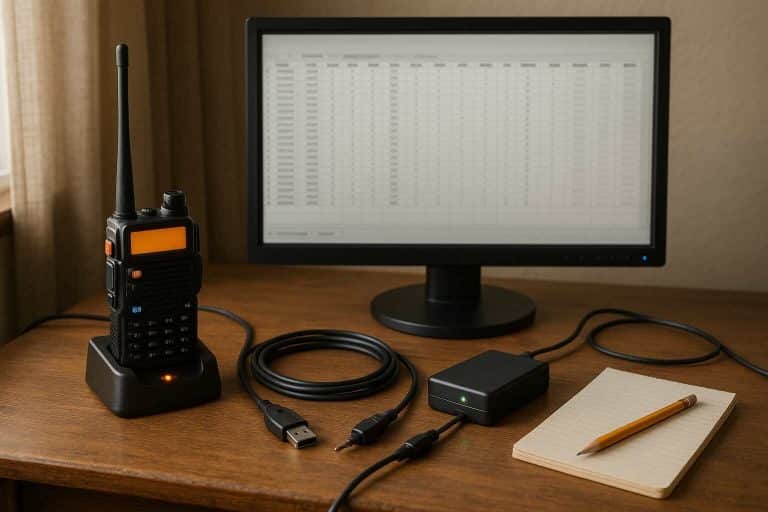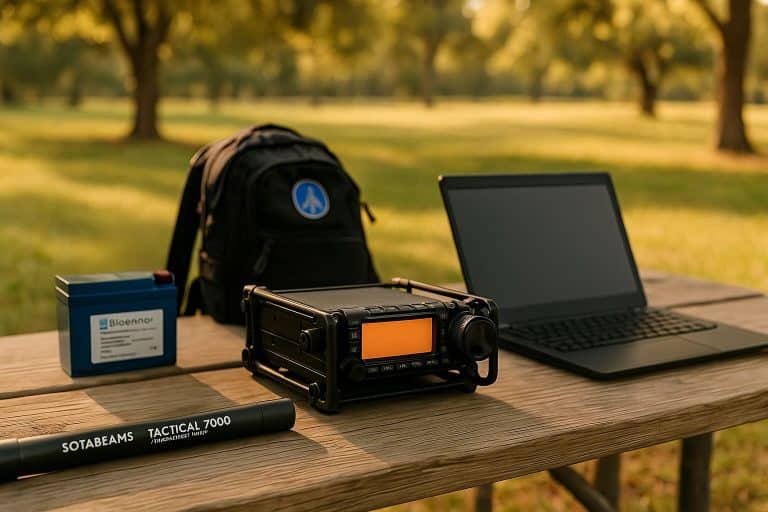I love modern tech. I’ve got apps for everything, cloud backups on cloud backups, and a phone that never leaves my pocket. But the first time I listened to a hurricane net roll traffic—people in North Carolina asking for updates on loved ones, volunteers offering to drive to nearby towns to check in person—it hit me: when the grid stumbles, people talking to people still works.
Ham radio isn’t a nostalgia project. It’s a people‑powered network that keeps humming when towers, fiber, and app servers tap out. In this post, I’ll show you why amateur radio still matters, how to practice now so you’re not guessing later (the ARRL Simulated Emergency Test is perfect for this), and a simple way to get started without stress. You don’t rise to the occasion—you fall to your level of training.
When “Always Online” Turns Into Silence
We live in a world of “five bars” and spinning status wheels. Then a storm rolls through. Power’s out. Cell sites are overloaded or dark. The map app can’t load. Group texts just… hang.
Here’s the hard truth: connected isn’t the same as resilient. Most of our everyday tools depend on a long chain of infrastructure—towers, the network links that connect them, data centers, cloud services. Break a few links and messages stall, even if your phone still shows a couple bars.
Ham radio takes a different path. You can talk directly to another person with nothing in the middle. No login. No subscription. No “try again later.” Just a radio, an antenna, and some basic etiquette.
What Ham Radio Actually Solves
Infrastructure independence
You can communicate radio‑to‑radio without towers, internet, or paid services. That’s a big deal when the grid is messy.
- Set‑and‑forget monitoring. Park a radio on digital modes and let it listen while you handle life.
- JS8Call (you might hear folks refer to community activity like the “Ghost Net”) lets stations exchange low‑power, low‑SNR messages and heartbeats. Great for situational awareness.
- Peer‑to‑Peer Winlink enables direct email/forms between stations without internet. You can leave a node listening or schedule mailbox polls.
- Heads‑up: You can listen all you want—no license required to monitor amateur radio. Only transmitting requires a license (except true life‑or‑limb emergencies). During active events, defer to net control, keep transmissions short and relevant, and follow your band plan.
One‑to‑many efficiency
Nets let a single station reach dozens of listeners quickly. That’s perfect for passing road closures, shelter info, or health‑and‑welfare updates.
Local and regional reach
- VHF/UHF (simplex and repeaters) cover neighborhoods and cities.
- HF reaches across counties and states for wider health‑and‑welfare traffic when the connections between towers are down.
Power resilience
Radios run happily on 12V batteries, solar, and even your vehicle. No grid? No problem. Some radios are even able to leverage battery packs populated with standard AA batteries.
Interoperability
Start with plain voice and a simple handheld. Add digital modes—Winlink, APRS, JS8Call, even mesh—when you’re ready. Grow at your own pace.
When the Grid Stumbles: Recent Lessons
Every year, we see the same pattern with hurricanes, tornadoes, derechos, wildfires, and ice storms:
- What breaks: commercial power, the connections between cell towers, last‑mile internet, cloud‑based app services.
- What works: battery‑backed radios, local simplex nets, and well‑run HF control stations.
Think of fast‑moving inland wind events like a derecho ripping through multiple states in a single day. Or wildfires that knock out power and fiber while communities are still evacuating. In coastal storms, flooding and wind take turns toppling infrastructure. Through all of it, trained amateur operators pass traffic: shelter status, road closures, supply needs, and yes—welfare checks for families who can’t get a text through.
How Emergency Ham Radio Works (Plain English)
You’ll hear a few acronyms. The idea is simple: organized volunteers, clear procedures.
- ARES (Amateur Radio Emergency Service) and RACES (Radio Amateur Civil Emergency Service). Volunteer programs that support served agencies (Emergency Management (EM), Red Cross, hospitals, etc.); ARES is coordinated by ARRL for day‑to‑day incidents/exercises, while RACES is activated by government emergency management during declared emergencies.
- SKYWARN. Trained spotters who feed real‑time weather reports to the National Weather Service.
- Hurricane Watch Net (HWN). During tropical systems, HWN operators gather on published frequencies to collect reports and relay critical information when infrastructure is compromised.
Net discipline keeps everything moving: check in, listen for instructions, pass traffic efficiently.
What traffic sounds like:
- Net Control gathers requests and priorities.
- Field operators collect info—shelter status, road blocks, welfare checks.
- Operators relay results back; Net Control disseminates to those who need it.
It’s radio. Keep sensitive details minimal. Share what helps.
ARRL SET: Your Low‑Risk Practice Ground
The ARRL Simulated Emergency Test (SET) runs in October (usually the first full weekend, though local groups may vary). It’s a nationwide exercise focused on message handling, net operations, and served‑agency workflows.
Why it matters: practice builds habits. You learn your gear, your local coverage, and your gaps—before a real storm.
First‑timer plan:
- Find a local ARES group or club. Note times, frequencies, and expectations.
- Check in to at least one voice net.
- Send/receive one formal message (ICS‑213 or radiogram) correctly.
- Map who you can reach on simplex vs. repeaters and note dead spots.
- Debrief: what failed, what to fix this month.
Mini‑checklist: spare battery, headset/mic, printed local frequencies, basic forms, paper & pencil (a weatherproof notebook like Rite in the Rain is clutch in bad weather), small first‑aid, water, snacks.
Hurricane Watch Net: Listening and Helping the Right Way
The Hurricane Watch Net coordinates hurricane‑related reports and relays, especially when normal channels are swamped.
If you’re outside the impact zone, listen first. Don’t add to the QRM.
If you’re in the impact zone and it’s safe to transmit, keep reports concise and factual: location, conditions, specific needs. Net Control’s job is triage—short, clear transmissions help everyone.
Pro tip: bookmark HWN’s website and your local weather net details. Print them for your go‑kit.
“But I’ve Got a Smartphone / Starlink / Sat Messenger…”
Use everything you can. Just know the tradeoffs.
- Congestion and choke points. Cellular voice/data jams. Apps depend on cloud services and the hidden network links in between.
- Physical fragility. Towers, fiber, and power feeds are all breakable. Satellites need clear sky and power.
- Ham complements, not replaces. A sat messenger is great for point‑to‑point. A ham net is great for community‑level awareness. Bridge tools when it makes sense—Winlink email over HF or VHF can move forms without the internet.
But what about GMRS?
If you’re not ready to jump into amateur radio yet, GMRS (General Mobile Radio Service) is a solid on‑ramp with a lower barrier.
- License: No exam. One FCC license covers your immediate family.
- Range & repeaters: Ideal for neighborhood/town coverage, especially where GMRS repeaters exist. Handheld‑to‑handheld is line‑of‑sight.
- Gear: Use FCC‑certified GMRS radios; many dual‑band ham handhelds aren’t certified for GMRS transmit.
- Best use cases: Family coordination, off‑road/adventure caravans, neighborhood teams during storms.
- Limits vs. ham: Primarily voice, no HF, limited data options, and less integration with ARES/RACES. For wide‑area nets and served‑agency work, ham radio is still the tool.
Bottom line: Keep a couple GMRS handhelds for family/simplex use and lean on ham radio for training, nets, and regional coverage.
Learn Now, Not During the Storm
Getting licensed is straightforward, and it opens a whole world of practice before you need it.
- Licensing path: Technician → General → Extra. Study with HamStudy, W4EEY, Ham Radio Crash Course, your local club—and see my Ultimate Ham Radio License Guide for a simple, step‑by‑step plan.
- Optional: GMRS has a lower barrier (no exam; one FCC license covers your family) and works well for local coordination. It complements—doesn’t replace—ham radio’s wider reach, training, and nets.
- Start with a radio you’ll actually use. A VHF/UHF handheld or a simple mobile is perfect. Program local repeaters and a few simplex channels. Do a weekly check‑in.
- Build a tiny power kit. 12V battery + Anderson Powerpoles + charger. Add a small solar panel when you’re ready.
- Stack small skill reps:
- Listen to weekly nets and jot down who you hear and where they are.
- Try a simplex contact across town.
- Learn one formal message format and practice it once a month.
- Dip your toes into portable ops with Parks on the Air — Learn Portable Radio. Calm weather. Low stress. Big confidence boost.
Quick Start: Set‑and‑Forget Digital Monitoring
Want to quietly build situational awareness without babysitting a radio? Leave a station listening.
Gear: HF radio (or VHF/UHF for local Winlink) with a sound card; small computer; JS8Call and/or Winlink Express; weatherproof notebook.
Steps:
- Park JS8Call on a regional frequency and watch for heartbeats/relays.
- Schedule Winlink peer‑to‑peer mailbox polls with a nearby operator.
- Keep power simple: 12V battery; add modest solar if you like.
Reminder: Listening is always okay. Transmit only within your license and with good net etiquette.
True Emergencies and No‑License Transmitting
If it’s critical to life or limb and no other means is available, you may use any radio at your disposal to call for help.
How to do it well:
- Say “Emergency traffic” clearly. Give your location (GPS if known), what happened, how many people, and what you need.
- Listen for net control or any station responding. Follow their directions. Keep it short.
- Once help is on the way, clear the frequency.
After the event, consider getting licensed so next time you’re part of the solution from the start.
Objections and Quick Rebuttals
- “Ham radio is obsolete.” Radios don’t need the cloud. People + procedure beat outages.
- “It’s too technical.” Start with voice and a $50–$200 radio. Skills compound with a little practice.
- “No one to talk to.” Weekly nets, QST special event stations, POTA/SOTA activators, Winlink Wednesday, and the October SET give you instant on‑ramps.
People > Infrastructure
Those voices at the start—the questions about loved ones in North Carolina, the volunteers willing to drive across town—are why I keep a radio in my kit. When the grid stumbles, people talking to people still works. That’s the whole case for amateur radio in one line.
In plain terms, radio sidesteps the fragile chain of towers, links, data centers, and apps. One‑to‑many nets share what matters fast. VHF/UHF covers your neighborhood; HF reaches the next counties. A small 12V battery keeps you on the air when the lights go dark. And you can even leave a station listening on digital modes like JS8Call or peer‑to‑peer Winlink to quietly build situational awareness.
The structure is simple, too: ARES/RACES, SKYWARN, and the Hurricane Watch Net coordinate volunteers who follow net discipline and get traffic where it needs to go. You don’t rise to the occasion—you fall to your level of training. So train.
Start small and steady. Put the ARRL Simulated Emergency Test on your October calendar and treat it like a no‑pressure drill. Check in to a weekly net. Try a simplex contact across town. Build a tiny power kit and toss a weatherproof notebook in your bag. If you like practicing outside, a calm day of POTA builds real confidence.
And if it’s life or limb and nothing else works, key up and ask for help. Be clear, be brief, listen for net control—and afterward, get licensed so you can be part of the solution from the start. My Ultimate Ham Radio License Guide walks you through it, and HWN.org is worth bookmarking.
If you do one thing next, make it this: pick a single action—find a local net, add SET to your calendar, or set up a simple battery‑powered station—and start building the level of training you’ll fall to when it counts.







